Hyundai Elantra 2014 Owner's Manual
Manufacturer: HYUNDAI, Model Year: 2014, Model line: Elantra, Model: Hyundai Elantra 2014Pages: 668, PDF Size: 35.58 MB
Page 581 of 668
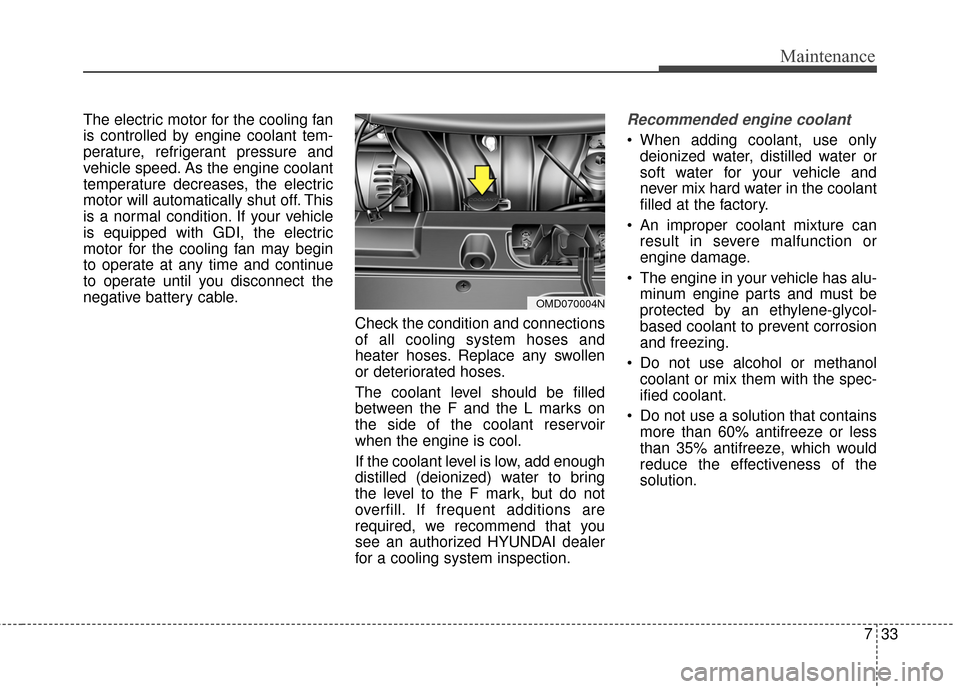
733
Maintenance
The electric motor for the cooling fan
is controlled by engine coolant tem-
perature, refrigerant pressure and
vehicle speed. As the engine coolant
temperature decreases, the electric
motor will automatically shut off. This
is a normal condition. If your vehicle
is equipped with GDI, the electric
motor for the cooling fan may begin
to operate at any time and continue
to operate until you disconnect the
negative battery cable.Check the condition and connections
of all cooling system hoses and
heater hoses. Replace any swollen
or deteriorated hoses.
The coolant level should be filled
between the F and the L marks on
the side of the coolant reservoir
when the engine is cool.
If the coolant level is low, add enough
distilled (deionized) water to bring
the level to the F mark, but do not
overfill. If frequent additions are
required, we recommend that you
see an authorized HYUNDAI dealer
for a cooling system inspection.Recommended engine coolant
When adding coolant, use onlydeionized water, distilled water or
soft water for your vehicle and
never mix hard water in the coolant
filled at the factory.
An improper coolant mixture can result in severe malfunction or
engine damage.
The engine in your vehicle has alu- minum engine parts and must be
protected by an ethylene-glycol-
based coolant to prevent corrosion
and freezing.
Do not use alcohol or methanol coolant or mix them with the spec-
ified coolant.
Do not use a solution that contains more than 60% antifreeze or less
than 35% antifreeze, which would
reduce the effectiveness of the
solution.
OMD070004N
Page 582 of 668
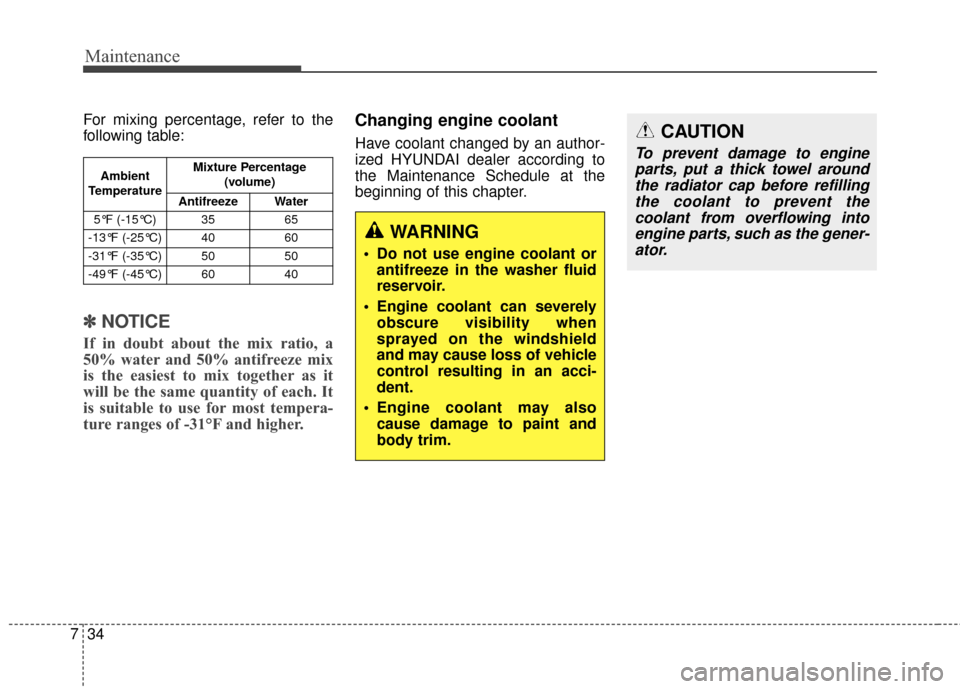
Maintenance
34
7
For mixing percentage, refer to the
following table:
✽ ✽
NOTICE
If in doubt about the mix ratio, a
50% water and 50% antifreeze mix
is the easiest to mix together as it
will be the same quantity of each. It
is suitable to use for most tempera-
ture ranges of -31°F and higher.
Changing engine coolant
Have coolant changed by an author-
ized HYUNDAI dealer according to
the Maintenance Schedule at the
beginning of this chapter.CAUTION
To prevent damage to engine
parts, put a thick towel aroundthe radiator cap before refillingthe coolant to prevent thecoolant from overflowing intoengine parts, such as the gener-ator.
WARNING
Do not use engine coolant or antifreeze in the washer fluid
reservoir.
Engine coolant can severely obscure visibility when
sprayed on the windshield
and may cause loss of vehicle
control resulting in an acci-
dent.
Engine coolant may also cause damage to paint and
body trim.
Ambient
Temperature Mixture Percentage
(volume)
Antifreeze Water
5°F (-15°C) 35 65
-13°F (-25°C) 40 60
-31°F (-35°C) 50 50
-49°F (-45°C) 60 40
Page 583 of 668
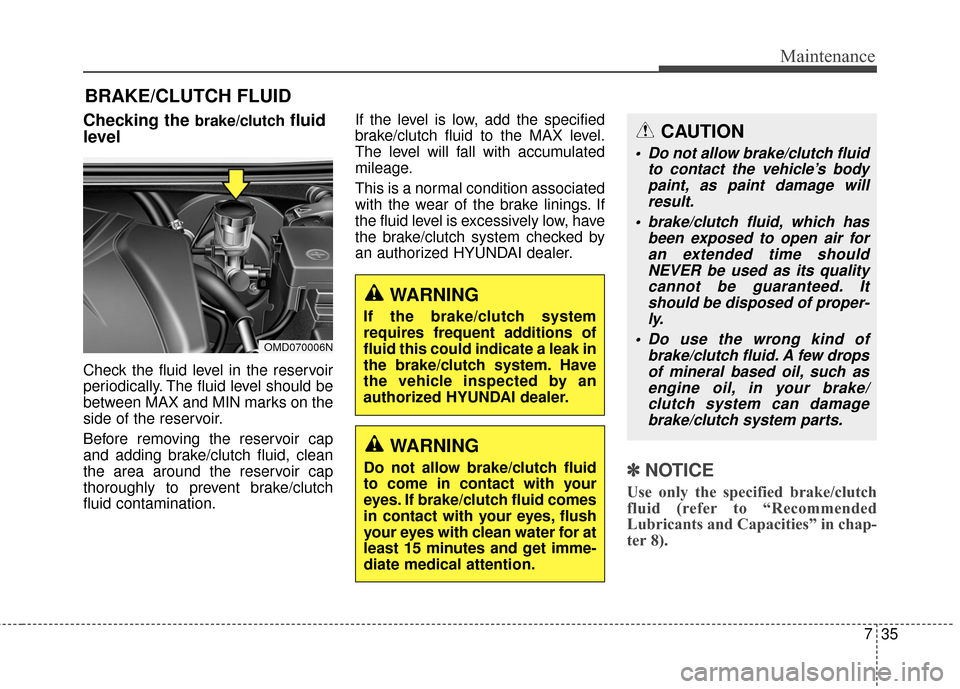
735
Maintenance
BRAKE/CLUTCH FLUID
Checking the brake/clutchfluid
level
Check the fluid level in the reservoir
periodically. The fluid level should be
between MAX and MIN marks on the
side of the reservoir.
Before removing the reservoir cap
and adding brake/clutch fluid, clean
the area around the reservoir cap
thoroughly to prevent brake/clutch
fluid contamination. If the level is low, add the specified
brake/clutch fluid to the MAX level.
The level will fall with accumulated
mileage.
This is a normal condition associated
with the wear of the brake linings. If
the fluid level is excessively low, have
the brake/clutch system checked by
an authorized HYUNDAI dealer.
✽ ✽
NOTICE
Use only the specified brake/clutch
fluid (refer to “Recommended
Lubricants and Capacities” in chap-
ter 8).
WARNING
If the brake/clutch system
requires frequent additions of
fluid this could indicate a leak in
the brake/clutch system. Have
the vehicle inspected by an
authorized HYUNDAI dealer.
WARNING
Do not allow brake/clutch fluid
to come in contact with your
eyes. If brake/clutch fluid comes
in contact with your eyes, flush
your eyes with clean water for at
least 15 minutes and get imme-
diate medical attention.
CAUTION
Do not allow brake/clutch fluid
to contact the vehicle’s bodypaint, as paint damage willresult.
brake/clutch fluid, which has been exposed to open air foran extended time shouldNEVER be used as its qualitycannot be guaranteed. Itshould be disposed of proper-ly.
Do use the wrong kind of brake/clutch fluid. A few dropsof mineral based oil, such asengine oil, in your brake/clutch system can damagebrake/clutch system parts.
OMD070006N
Page 584 of 668
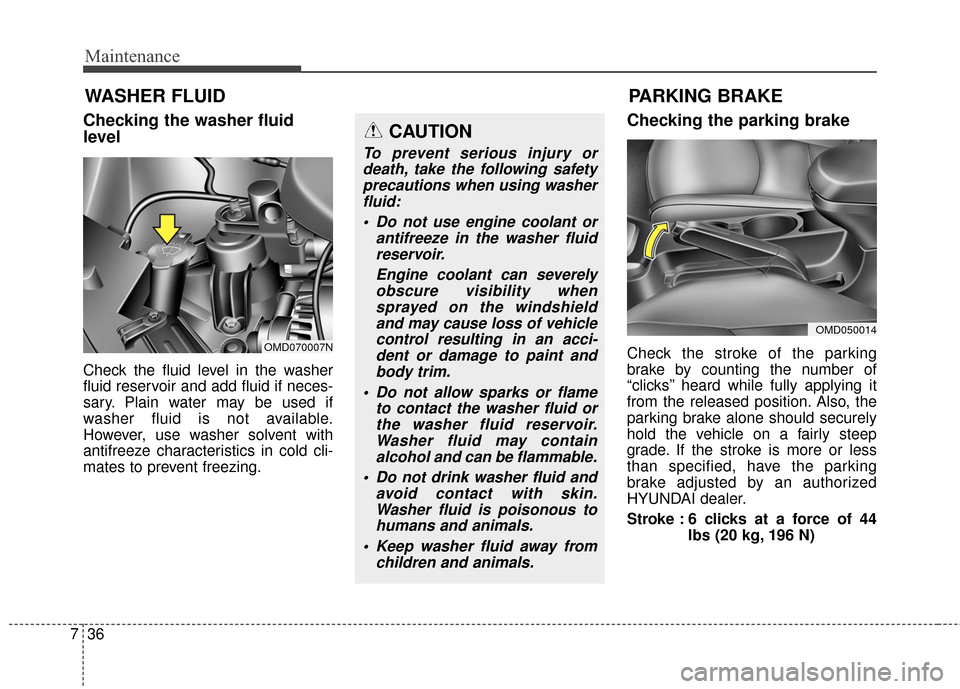
Maintenance
36
7
WASHER FLUID
Checking the washer fluid
level
Check the fluid level in the washer
fluid reservoir and add fluid if neces-
sary. Plain water may be used if
washer fluid is not available.
However, use washer solvent with
antifreeze characteristics in cold cli-
mates to prevent freezing.
Checking the parking brake
Check the stroke of the parking
brake by counting the number of
“clicks’’ heard while fully applying it
from the released position. Also, the
parking brake alone should securely
hold the vehicle on a fairly steep
grade. If the stroke is more or less
than specified, have the parking
brake adjusted by an authorized
HYUNDAI dealer.
Stroke : 6 clicks at a force of 44
lbs (20 kg, 196 N)
PARKING BRAKE
OMD070007N
OMD050014
CAUTION
To prevent serious injury ordeath, take the following safetyprecautions when using washerfluid:
Do not use engine coolant or antifreeze in the washer fluidreservoir.
Engine coolant can severelyobscure visibility whensprayed on the windshieldand may cause loss of vehiclecontrol resulting in an acci-dent or damage to paint andbody trim.
Do not allow sparks or flame to contact the washer fluid orthe washer fluid reservoir.Washer fluid may containalcohol and can be flammable.
Do not drink washer fluid and avoid contact with skin.Washer fluid is poisonous tohumans and animals.
Keep washer fluid away from children and animals.
Page 585 of 668
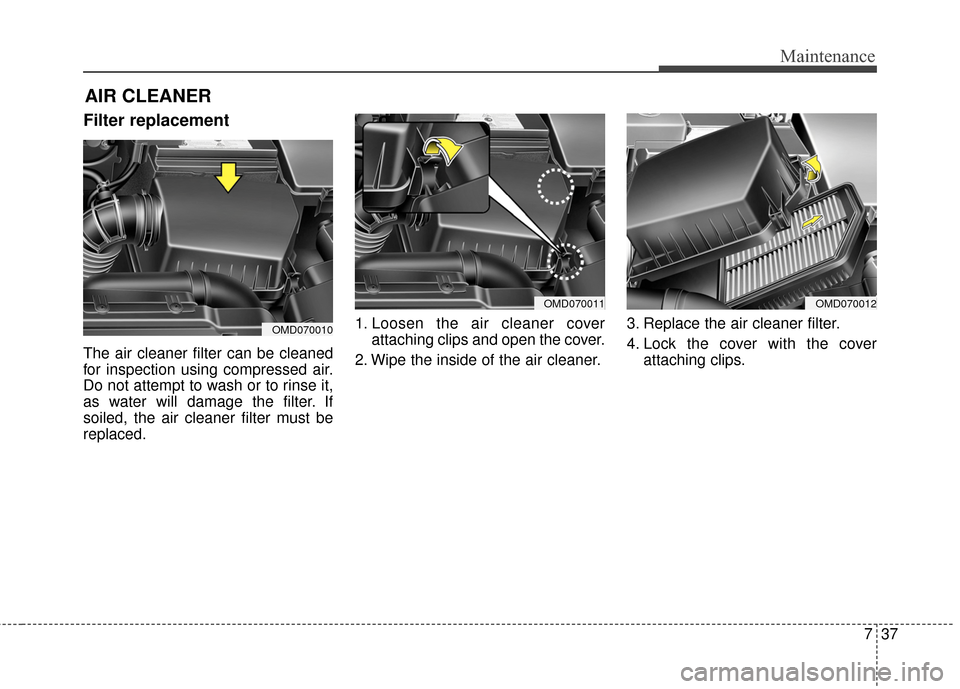
737
Maintenance
AIR CLEANER
Filter replacement
The air cleaner filter can be cleaned
for inspection using compressed air.
Do not attempt to wash or to rinse it,
as water will damage the filter. If
soiled, the air cleaner filter must be
replaced.1. Loosen the air cleaner cover
attaching clips and open the cover.
2. Wipe the inside of the air cleaner. 3. Replace the air cleaner filter.
4. Lock the cover with the cover
attaching clips.
OMD070010
OMD070011OMD070012
Page 586 of 668
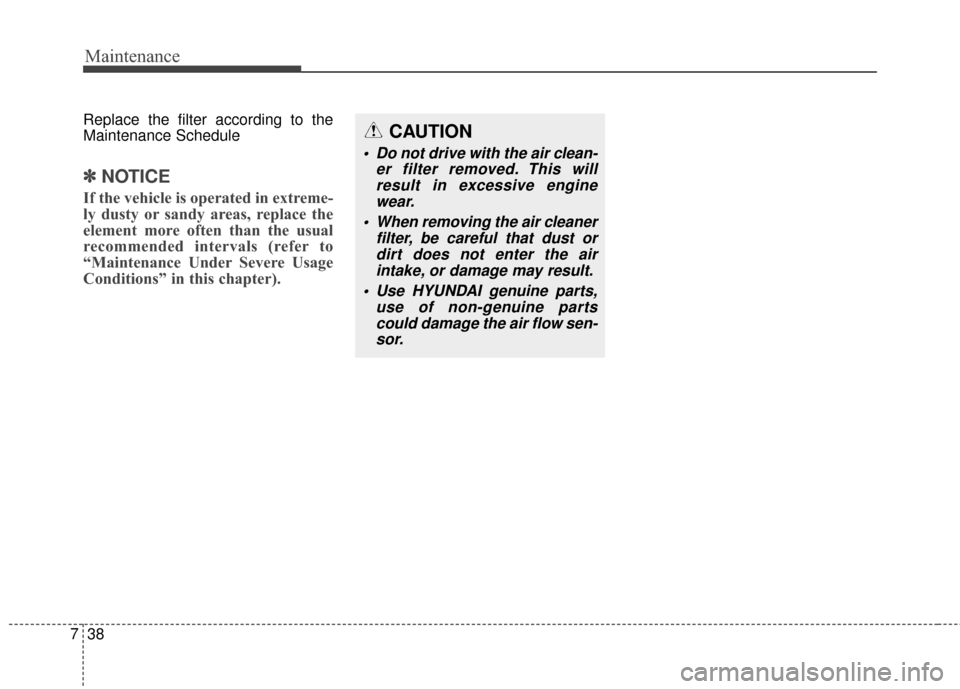
Maintenance
38
7
Replace the filter according to the
Maintenance Schedule
✽ ✽
NOTICE
If the vehicle is operated in extreme-
ly dusty or sandy areas, replace the
element more often than the usual
recommended intervals (refer to
“Maintenance Under Severe Usage
Conditions” in this chapter).
CAUTION
Do not drive with the air clean-
er filter removed. This willresult in excessive enginewear.
When removing the air cleaner filter, be careful that dust ordirt does not enter the airintake, or damage may result.
Use HYUNDAI genuine parts, use of non-genuine partscould damage the air flow sen-sor.
Page 587 of 668
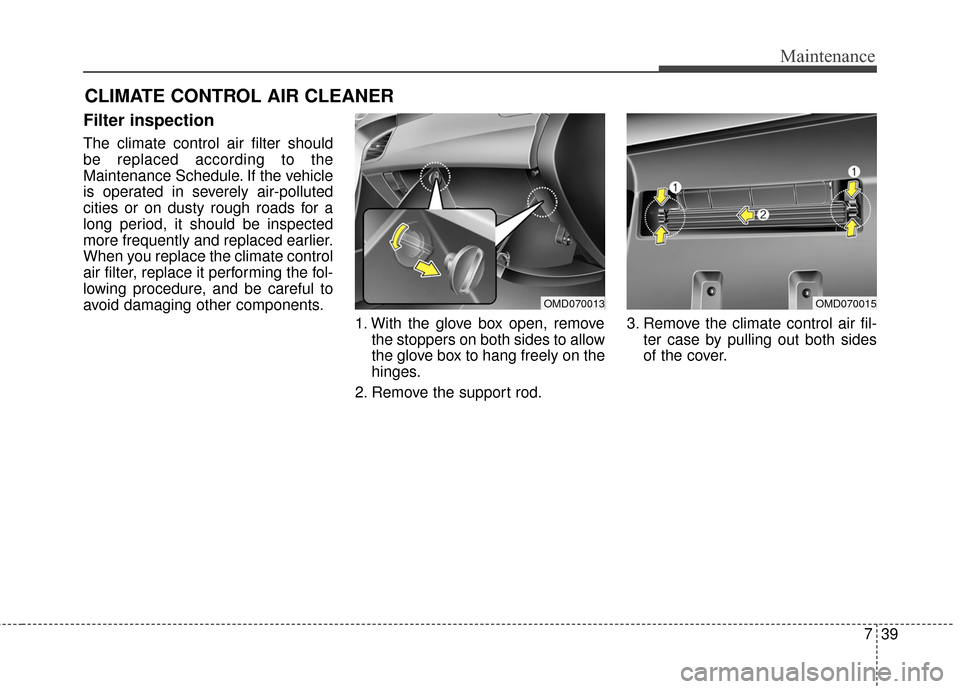
739
Maintenance
CLIMATE CONTROL AIR CLEANER
Filter inspection
The climate control air filter should
be replaced according to the
Maintenance Schedule. If the vehicle
is operated in severely air-polluted
cities or on dusty rough roads for a
long period, it should be inspected
more frequently and replaced earlier.
When you replace the climate control
air filter, replace it performing the fol-
lowing procedure, and be careful to
avoid damaging other components.1. With the glove box open, removethe stoppers on both sides to allow
the glove box to hang freely on the
hinges.
2. Remove the support rod. 3. Remove the climate control air fil-
ter case by pulling out both sides
of the cover.
OMD070013OMD070015
Page 588 of 668
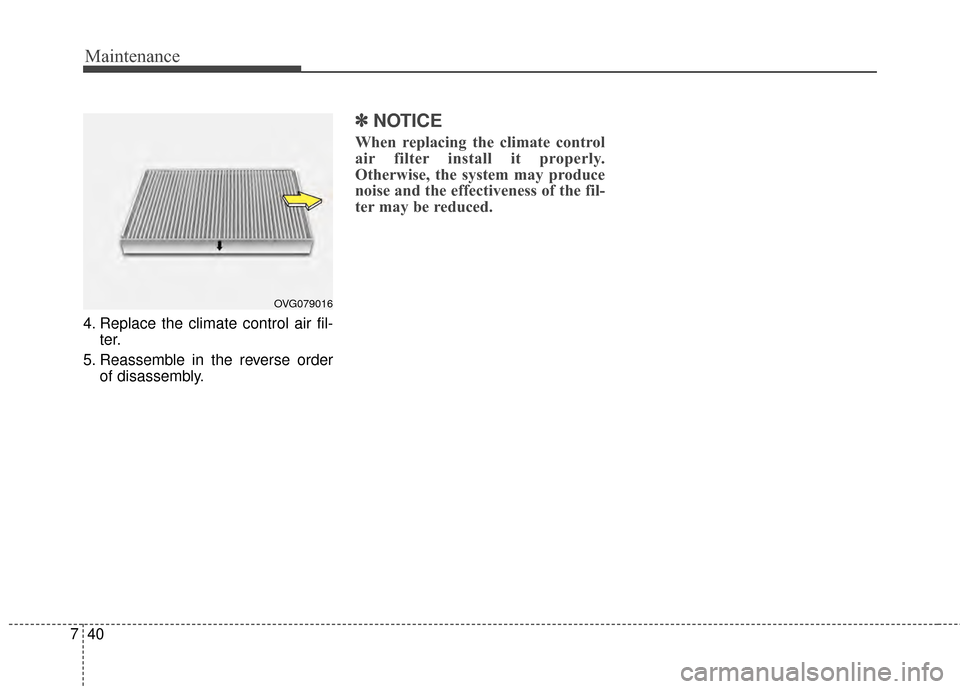
Maintenance
40
7
4. Replace the climate control air fil-
ter.
5. Reassemble in the reverse order of disassembly.
✽
✽NOTICE
When replacing the climate control
air filter install it properly.
Otherwise, the system may produce
noise and the effectiveness of the fil-
ter may be reduced.
OVG079016
Page 589 of 668
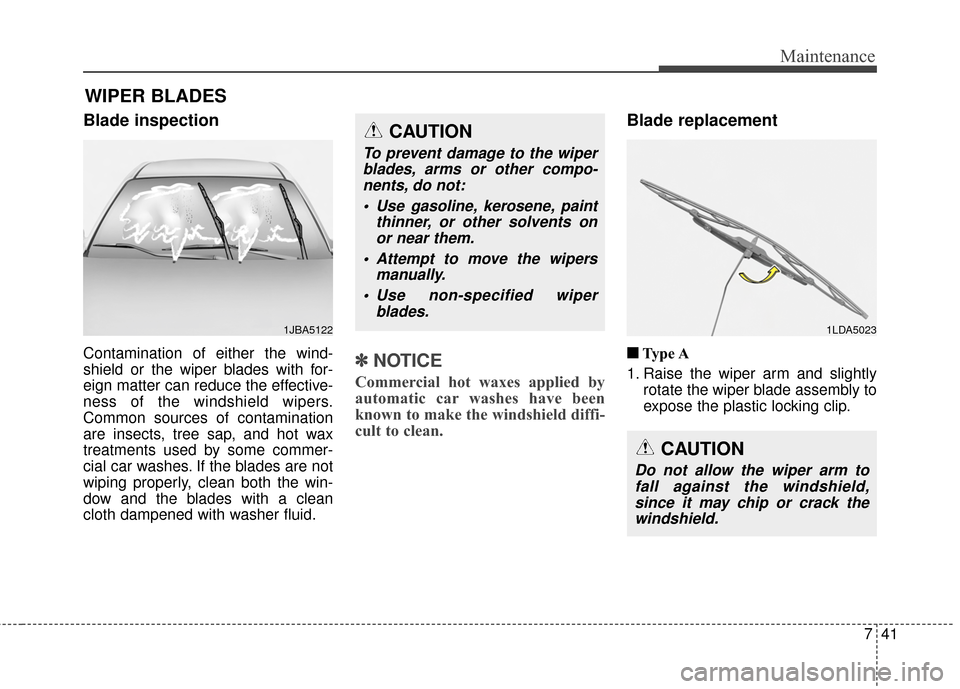
741
Maintenance
WIPER BLADES
Blade inspection
Contamination of either the wind-
shield or the wiper blades with for-
eign matter can reduce the effective-
ness of the windshield wipers.
Common sources of contamination
are insects, tree sap, and hot wax
treatments used by some commer-
cial car washes. If the blades are not
wiping properly, clean both the win-
dow and the blades with a clean
cloth dampened with washer fluid.✽ ✽NOTICE
Commercial hot waxes applied by
automatic car washes have been
known to make the windshield diffi-
cult to clean.
Blade replacement
■ ■ Type A
1. Raise the wiper arm and slightly rotate the wiper blade assembly to
expose the plastic locking clip.
1JBA5122
CAUTION
Do not allow the wiper arm tofall against the windshield,since it may chip or crack thewindshield.
CAUTION
To prevent damage to the wiperblades, arms or other compo-nents, do not:
Use gasoline, kerosene, paint thinner, or other solvents onor near them.
Attempt to move the wipers manually.
Use non-specified wiper blades.
1LDA5023
Page 590 of 668
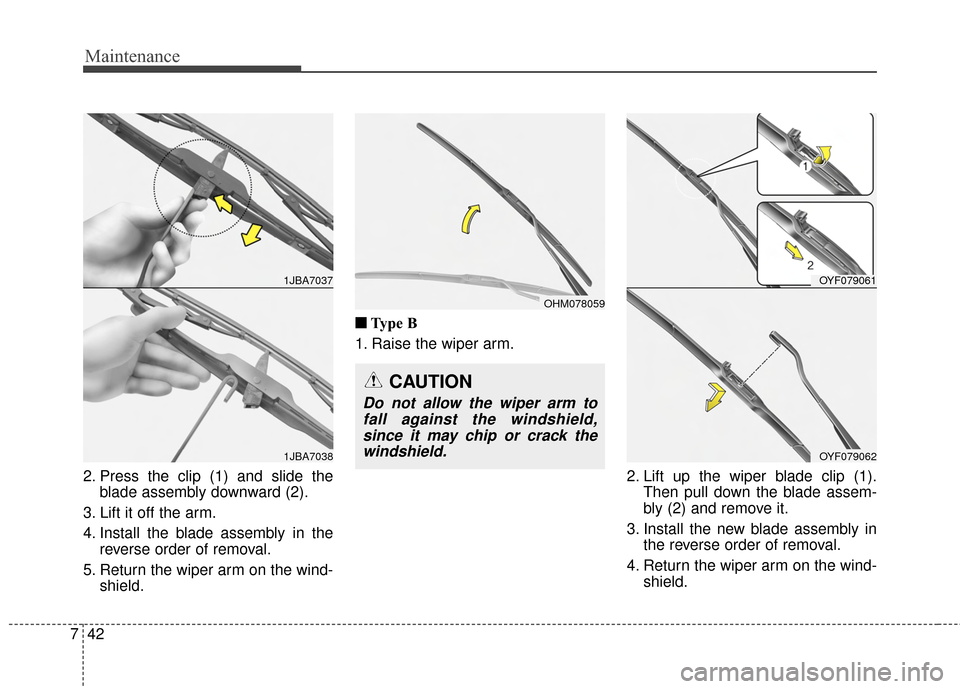
Maintenance
42
7
2. Press the clip (1) and slide the
blade assembly downward (2).
3. Lift it off the arm.
4. Install the blade assembly in the reverse order of removal.
5. Return the wiper arm on the wind- shield. ■ ■
Type B
1. Raise the wiper arm.
2. Lift up the wiper blade clip (1).Then pull down the blade assem-
bly (2) and remove it.
3. Install the new blade assembly in the reverse order of removal.
4. Return the wiper arm on the wind- shield.
1JBA7037
1JBA7038
OHM078059
CAUTION
Do not allow the wiper arm tofall against the windshield,since it may chip or crack thewindshield.
OYF079061
OYF079062